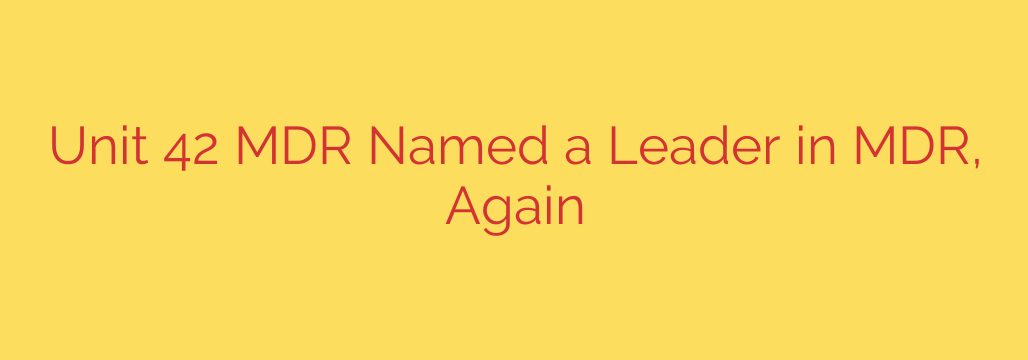
What Sets a Leader in Managed Detection and Response (MDR) Apart?
In today’s complex and ever-evolving threat landscape, simply having security tools is no longer enough. Organizations are inundated with alerts, struggling with a persistent cybersecurity skills gap, and facing sophisticated adversaries who operate around the clock. This is where Managed Detection and Response (MDR) services have become essential, acting as a force multiplier for internal security teams.
However, not all MDR providers are created equal. Recent independent evaluations by leading industry analysts have shed light on what truly separates the leaders from the rest of the pack. It’s a combination of cutting-edge technology, unparalleled human expertise, and an unwavering focus on delivering tangible security outcomes—not just more alerts.
The Modern Mandate: Moving from Alerts to Outcomes
For years, security operations centers (SOCs) have been caught in a reactive cycle, chasing down an endless stream of notifications. This leads to alert fatigue, burnout, and the very real risk of a critical threat being missed in the noise.
Leading MDR services fundamentally shift this paradigm. The goal isn’t to forward alerts but to provide context-rich, verified incidents that require action. The true measure of an elite MDR service is its ability to manage the entire incident lifecycle, from initial detection and investigation to guided response and remediation, ultimately strengthening an organization’s security posture.
Key Attributes of a Top-Tier MDR Provider
Based on rigorous industry analysis, several core capabilities define a leader in the MDR space. These are the non-negotiable elements that businesses should look for when evaluating a security partner.
1. AI-Driven Detection at Scale
The sheer volume of data across endpoints, networks, cloud environments, and identity systems is impossible for humans to analyze alone. A superior MDR service is built on a foundation of artificial intelligence and machine learning. This technology is crucial for analyzing trillions of data points in real time, identifying subtle patterns of malicious activity, and detecting threats with incredible speed and precision. This AI-driven approach ensures that analysts focus their time on validated threats, not false positives.
2. Elite, Integrated Human Expertise
While technology provides scale, it’s the human element that delivers insight and decisive action. World-class MDR providers combine their powerful platform with a team of seasoned experts, including:
- Threat Hunters: Proactively search for hidden and emerging threats that automated systems might miss.
- Threat Researchers: Analyze global threat intelligence to understand attacker tactics, techniques, and procedures (TTPs).
- Security Analysts: Investigate, triage, and validate incidents 24/7/365.
- Incident Responders: Provide expert, step-by-step guidance to contain and eradicate threats quickly.
Technology must be paired with world-class human expertise to translate complex data into clear, actionable security intelligence.
3. Uncompromising Speed and Decisive Response
In cybersecurity, time is the most critical factor. The longer an attacker has inside a network, the more damage they can do. Therefore, a key differentiator for MDR leaders is their Mean Time to Respond (MTTR). The goal is to shrink the attacker’s window of opportunity to the absolute minimum. This is achieved through a combination of automated response actions and swift, expert-led containment measures. Top providers don’t just detect problems; they solve them, fast.
4. Holistic Visibility Across the Attack Surface
Attackers don’t limit themselves to a single entry point, and your defenses shouldn’t either. Complete visibility across the entire digital estate is critical for effective threat detection and response. A leading MDR service must be able to ingest data from and provide protection for all key areas, including endpoints (laptops, servers), cloud workloads, identity and access management systems, and network traffic. This comprehensive view ensures that there are no blind spots for adversaries to exploit.
Choosing the Right MDR Partner: Actionable Security Tips
Selecting an MDR provider is one of the most important security decisions your organization will make. To ensure you’re choosing a true leader, consider the following:
- Scrutinize the Technology: Ask how AI and automation are used to reduce false positives and accelerate detection. Does their platform integrate with your existing security tools?
- Evaluate the Experts: Inquire about the experience and certifications of their security analysts and threat hunters. What is their process for continuous training and staying ahead of new threats?
- Demand Outcome-Focused Metrics: Move beyond simple alert counts. Ask for metrics like Mean Time to Detect (MTTD) and Mean Time to Respond (MTTR). Look for a provider that guarantees specific service level agreements (SLAs).
- Look for Consistent Recognition: While not the only factor, consistent recognition as a “Leader” by reputable, independent analyst firms indicates a provider with a proven track record, a strong strategic vision, and a history of customer success.
Ultimately, partnering with a leading MDR service empowers your organization to move from a reactive to a proactive security posture, ensuring your most critical assets are protected around the clock by a team of the best human minds and the most advanced technology in the industry.
Source: https://www.paloaltonetworks.com/blog/2025/07/unit-42-mdr-recognized-leader/








